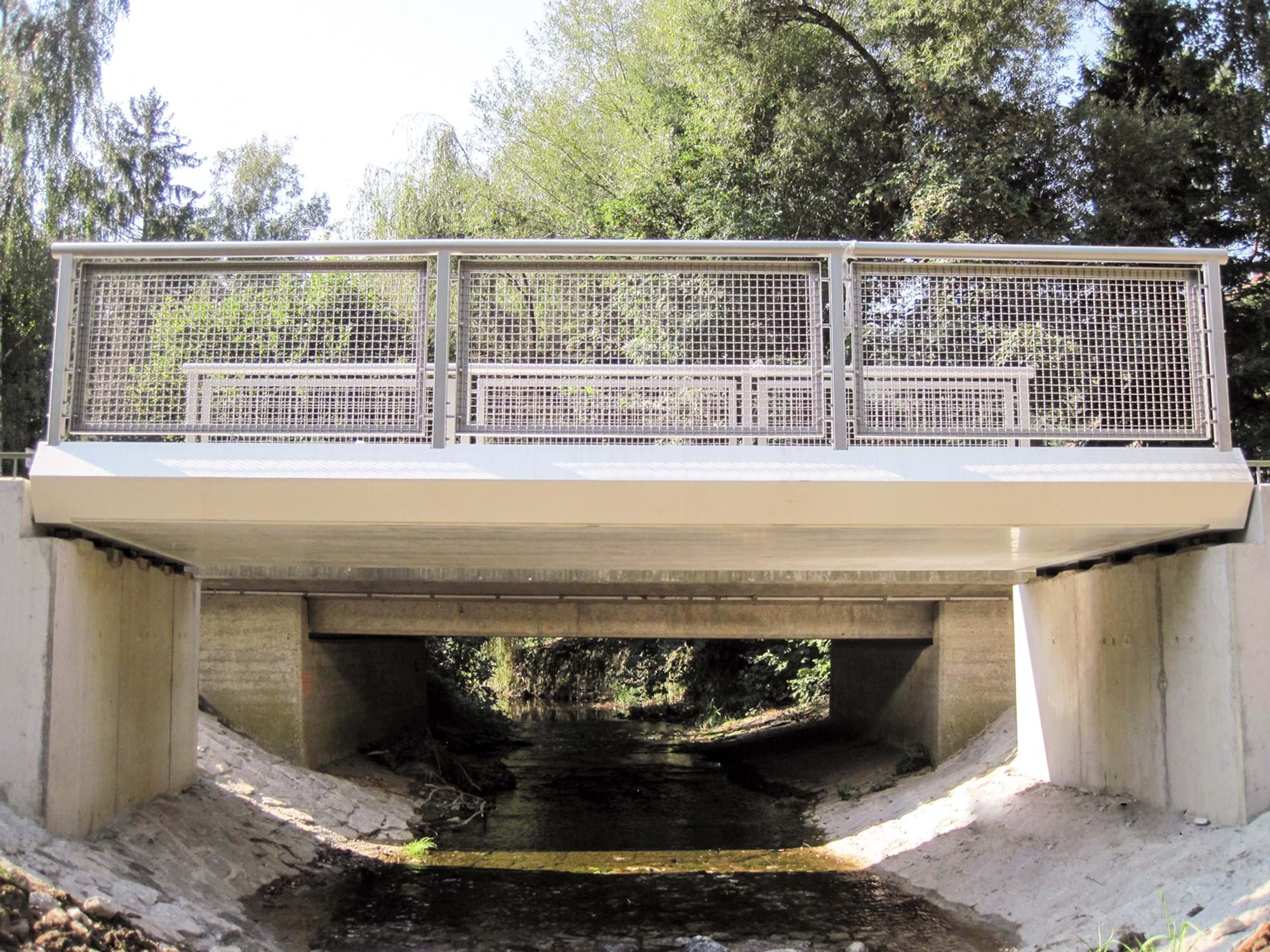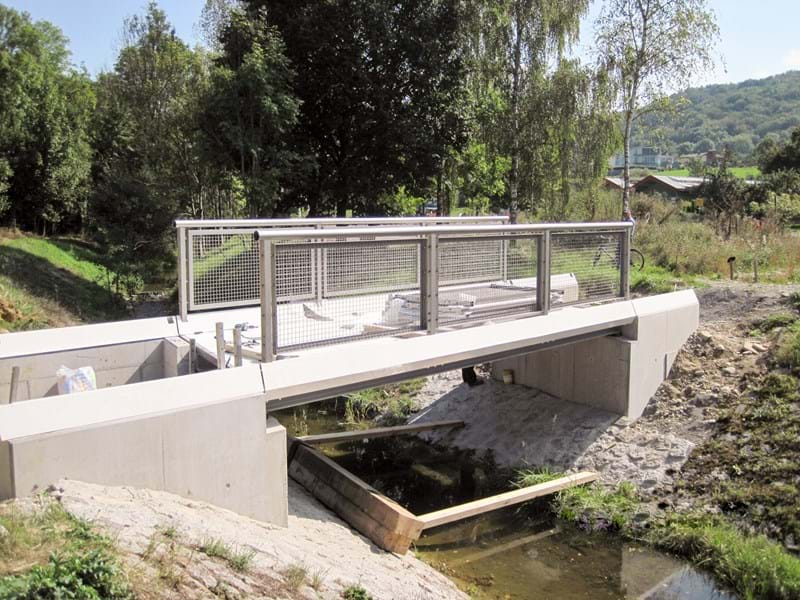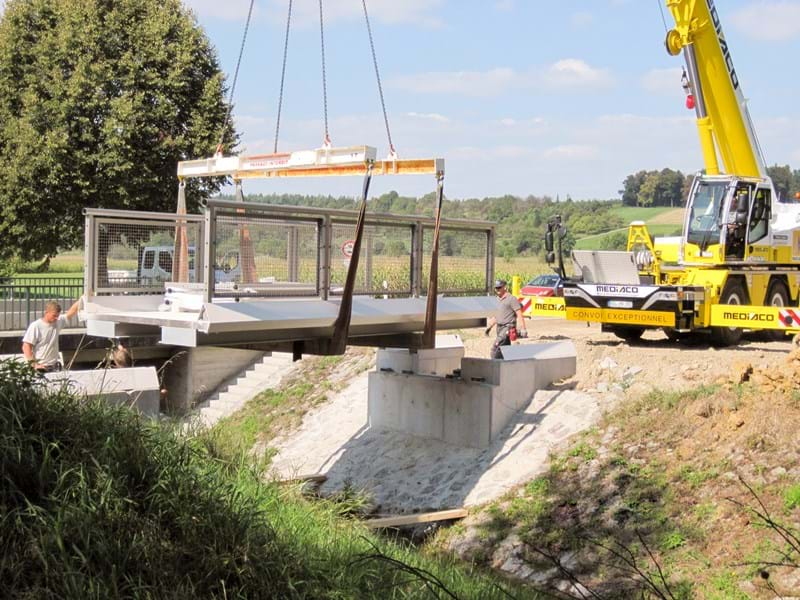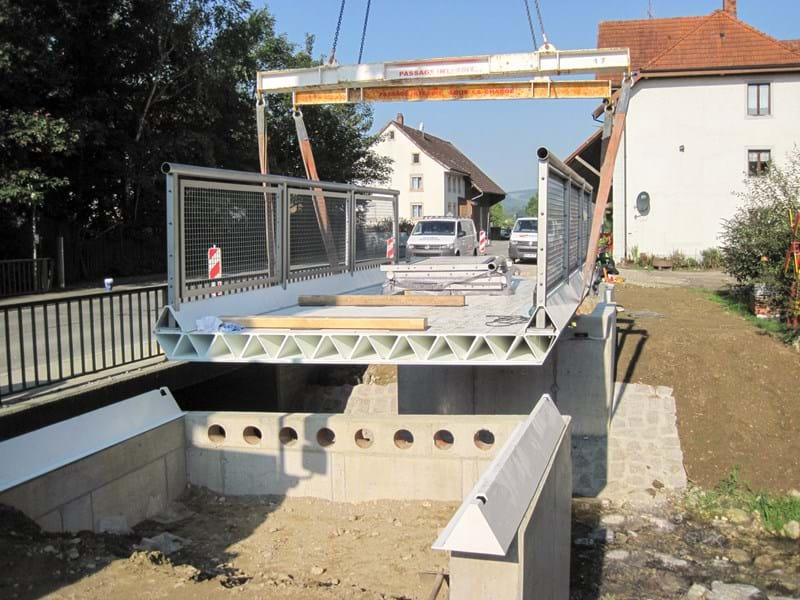

Fiberline Building Profiles A/S
Bridge 1: Fiberglass composite bridge with Fiberline Bridge Deck 600 bridge deck "Assets". Length approx. 7 m, full width 3,25 m and free width 2,90 m. Load 5.0 kN/m2 + 6.0 t traffic load. Total weight: 2 t Bridge 2: Hybrid bridge with Fiberline Bridge Deck 300 bridge deck and steel construction. Length approx. 7 m, full width 3,25 m and free width 2,90 m. Load 5.0 kN/m2 + 6.0 t traffic load. Total weight: 2 t
Faced with the challenge of constructing two bridges for a new pedestrian and cycle route, local politicians in Klettgau, Germany, opted for a durable building material that would future-proof their investment. The decision resulted in two composite bridges which externally look completely identical, but which internally contain differing structures precisely adapted to their new location.
The two new bridges, which are both seven metres long and are intended to span the Schwarzbach river, form part of a local modernisation programme consisting of no fewer than 32 bridges in Klettgau municipality in the German state of Baden-Württemberg. For the mayor of Klettgau, Volker Jungmann, it was vital to secure a long-term solution with minimal operating costs. The building material of choice was fibreglass composite, which is durable and will not weather, rot or rust:
"We opted to invest in the most future-proof solution, one ensuring minimal maintenance and low costs. And if we view the budget for the bridges in a lifetime perspective, then we have chosen the most cost-efficient solution," explains Volker Jungmann.
According to building contractors Holger Schulz, the innovative method of bridge building has also meant that the combined cost of constructing the two new bridges largely corresponds to the average cost of renovating similar bridges in the relevant modernisation programme. Due to the high cost of renovating the existing bridges, alternative construction materials are also being considered when planning new builds in order to enable operating, maintenance and repair costs to be reduced for subsequent generations.
Fibreglass composite was recommended by the German consulting engineers Mayer on account of its obvious advantages, particularly for bridges, in the form of high strength, high rigidity and low weight. As the 1.7 km-long route will form part of an extensive cycling network in Baden-Württemberg, it was also important that the two new bridges should contribute to the overall experience of the route.
"The slim fibreglass bridge profiles mean it is possible to create not only a very robust solution but also a wonderfully elegant bridge design. And thanks to the weather resistance of fibreglass, the bridges will continue looking like new for many years in the future," says Mayer's project manager Claus Baumgartner.
Due to the nature of the project it was decided to invest in two types of bridge: a composite bridge consisting exclusively of fibreglass profiles, and a hybrid bridge that by combining a steel construction and a fibreglass bridge deck creates a unique solution. In this solution the advantages of both materials are utilised – the rigidity of steel and the durability of fibreglass. The fibreglass provides a watertight covering for the steel substructure, thereby prolonging the life of the bridge as a whole. The result is a bridge which in terms of cost and quality is a competitive alternative to conventional designs in wood, concrete or steel.
Both bridge decks have been asphalted to achieve maximum skid-resistance, and as a commonly used material for bridges, asphalt is also familiar to those responsible for daily maintenance. Although differing structurally, the two bridges are designed to resemble each other in external appearance. Even to the trained eye, however, the bridges will look much the same as any other bridges generally encountered.
The prefabricated profiles were assembled in northern Germany by Schmees & Lühn GmbH & Co. KG, highly experienced bridge builders who are also specialised in GRP composite. The finished bridges were then transported to the installation site in Klettgau.
"GRP profiles make an excellent addition to our bridges, and now that we can also produce finished building structures they offer an unusual long-life solution. The relatively low lifetime bridge costs are also a bonus for local and regional authorities. In recent years we have registered an increasing number of enquiries for composite bridges and hybrid building methods. One reason for this has undoubtedly been the granting of German building approval, Allgemeine bauaufsichtliche Zulassung, for the structural profiles. As soon as similar approval exists for the HD Plank we expect a further acceleration in demand for composite bridges, which are popular in both new builds and renovations. We are extremely interested in the future development of composite as it represents a good alternative to wood, steel and concrete. Added to which, composite is also eco-friendly," says Alfred Lühn.
Despite its high strength, GRP composite is light in weight, which means that finished bridges are easy to lift into place at the installation site. For example, in Klettgau, Schmees & Lühn managed to install both bridges in just a single day, thereby minimising nuisance to other traffic - the new pedestrian and cycle route is adjacent to the busy LI63 highway which carries 3000 cars and more than 250 lorries every day.








Learn more about fibgreglass bicycle and pedestrian bridges.